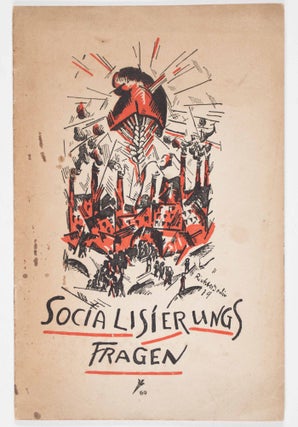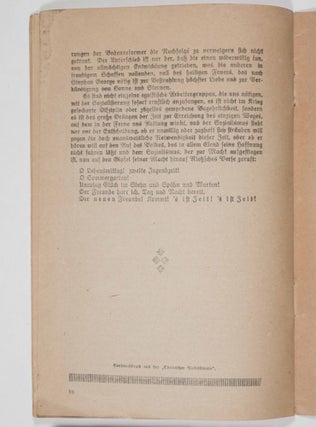Sozialisierung: Warum Was Wie Wann? (Socialization: Why What How When?)
Chemnitz: Chemnitzer Volksstimme, 1919. Special edition. Softcover. Octavo. 16pp. Original color-illustrated tan wraps with black lettering on spine, protected by modern mylar. Title page printed in red and black. Special edition of the Chemnitzer Volksstimme (Chemnitz People's Voice). The color lithograph on the cover by Heinrich Richter, signed and dated in plate, depicts a factory with fuming smoke stacks and rows of workers leaving the factory while a wheat ear ascends in a vessel in the beaming sky, captioned: Sozialisierungsfragen (Socialization Questions). A small torch with the number 69 printed next to it at the bottom of the page (Holstein, Blickfang: S. 463, 472, # 69).
Heinrich C. Richter (1884–1981) was a German Expressionistic painter and cofounder of the Neue Secession and the November Group in Berlin along with Max Pechstein, Georg Tappert and others. In 1902/3 he had studied at the Berlin Academy of Fine Arts but was suspended because of his participation in an exhibition of the Berlin Secession without permission by the Academy. Richter created numerous woodcuts for the famous magazine Der Sturm and worked as a set designer for film productions, including two films of Friedrich Wilhelm Murnau. Richter's work was deemed "entartet" (degenerate) by the Nazis and included in the infamous 1937 Munich exhibition. After the war Richter worked as a set designer for the Theater am Nollendorfplatz.
Herman Kranold was a political writer active for the German Social Democratic Party and as a politician in Saxony, Bavaria and Silesia. Kranold was arrested on the day of the Reichstags fire and due to the influence of his uncle Max Planck released. He emigrated via London to the United States where he worked on the economic situation of African Americans in Alabama and elsewhere. Socialization is a work written shortly after the failed German revolution in 1918. It was meant to be a blueprint for the restructuring of the German society and economy with a distinct social democratic signature after World War I. This reprint from the "Chemnitzer Volksstimme" is publication No. 69 in a series released by the Werbedienst Volksbeauftragter (Advertising Service of Agents of the People). Text in German, Gothic script. Wraps with light staining and age-toned along edges. Very good condition. Item #47808
Price: $95.00



